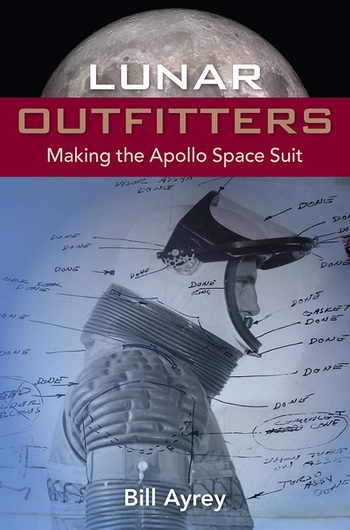Review: Lunar Outfittersby Jeff Foust
|
| Lunar Outfitters is more of a corporate history, focusing on how ILC developed the suit and the challenge sit overcame along the way. |
Those Apollo suits were built by a small company, ILC Industries (now ILC Dover.) Bill Ayrey, the author of the book Lunar Outfitters, joined the company as a test engineer after its Apollo heyday, when it was starting work on suits for the shuttle program. He became, though, the de facto company historian, collecting records and artifacts from the company’s work on the Apollo suits, which forms the basis of his book recounting that effort.
Lunar Outfitters is not the first book to explore the development of the Apollo spacesuits. A decade ago, Spacesuit: Fashioning Apollo examined the development of the suit (see “Review: Spacesuit”, The Space Review, March 28, 2011.) But while Spacesuit was a broader examination of the spacesuit, using the suit’s structure as a metaphor for examining a range of topics beyond the suit’s development, Lunar Outfitters is more of a corporate history, focusing on how ILC developed the suit and the challenge sit overcame along the way.
The company had been working for years to get into either military or NASA programs, proposing pressure suits to the Air Force and spacesuits to NASA. In 1962, it bid for the Apollo spacesuit, and NASA decided to effectively combine its bid with one from Hamilton Standard, making ILC a subcontractor to Hamilton Standard. The forced marriage, unsurprisingly, did not work out well, and when Hamilton Standard sought to dump ILC because of what it argued was poor performance, ILC asked NASA to rebid the competition. NASA did, and ILC won the contract outright.
ILC demonstrated it had the capability to build a suit that could protect spacewalking astronauts while giving them enough flexibility to walk around and do work on the lunar surface. It still, though, had to develop that suit, and also demonstrate it could work with NASA. That meant learning aerospace concepts like systems engineering and configuration management, which was foreign for a small company that often worked on an ad hoc basis (the book’s cover features an earlier project for the Air Force, with a pressure suit image full of handwritten annotations; an example, Ayrey said, of the lack of rigorous configuration management at ILC at the time.)
| The book’s cover features an earlier project for the Air Force, with a pressure suit image full of handwritten annotations; an example, Ayrey said, of the lack of rigorous configuration management at ILC at the time. |
The book is a mix of technical discussions of the development of the series of spacesuits used for Apollo, along with anecdotes from that effort. One from the latter category involved a seamstress who had to fly on short notice from ILC’s Delaware headquarters to the Kennedy Space Center to make a last-minute repair to a suit. Despite not having been on an airplane before, she made the trip, with the replacement part in a briefcase handcuffed to her. “She told me that she had some interesting conversations with the others in the [airport] bar that afternoon in Atlanta,” where she had a layover on her trip to Florida, he wrote.
The book also includes some discussion of how the suits performed on those missions, including debriefs from the astronauts that led to changes incorporated into the suits. For example, it was only after the Apollo 12 mission, when Pete Conrad and Alan Bean reported getting thirsty on their moonwalks, did suit designers add a drink bag attached to the inside of the helmet. Unfortunately, those discussions get condensed when it came to the later Apollo missions, when the suits were pushed to their limits, so we don’t hear much about issues such as lunar regolith degrading their performance.
ILC almost didn’t survive the post-Apollo period: a lack of work caused the company to shrink from nearly 1,000 employees to only a few dozen before it won business for the shuttle program, selling off surplus items in what effectively was a yard sale. (Ayrey notes that, at one point, there was a potential deal in the early 1970s to sell suits to the Soviets, reportedly as part of the Apollo-Soyuz program, but the contract was not approved by the US government.) Fortunately, the company survived and is now looking to play a role in the future development of lunar spacesuits, perhaps using the lessons learned more than a half-century ago.
Note: we are using a new commenting system, which may require you to create a new account.
